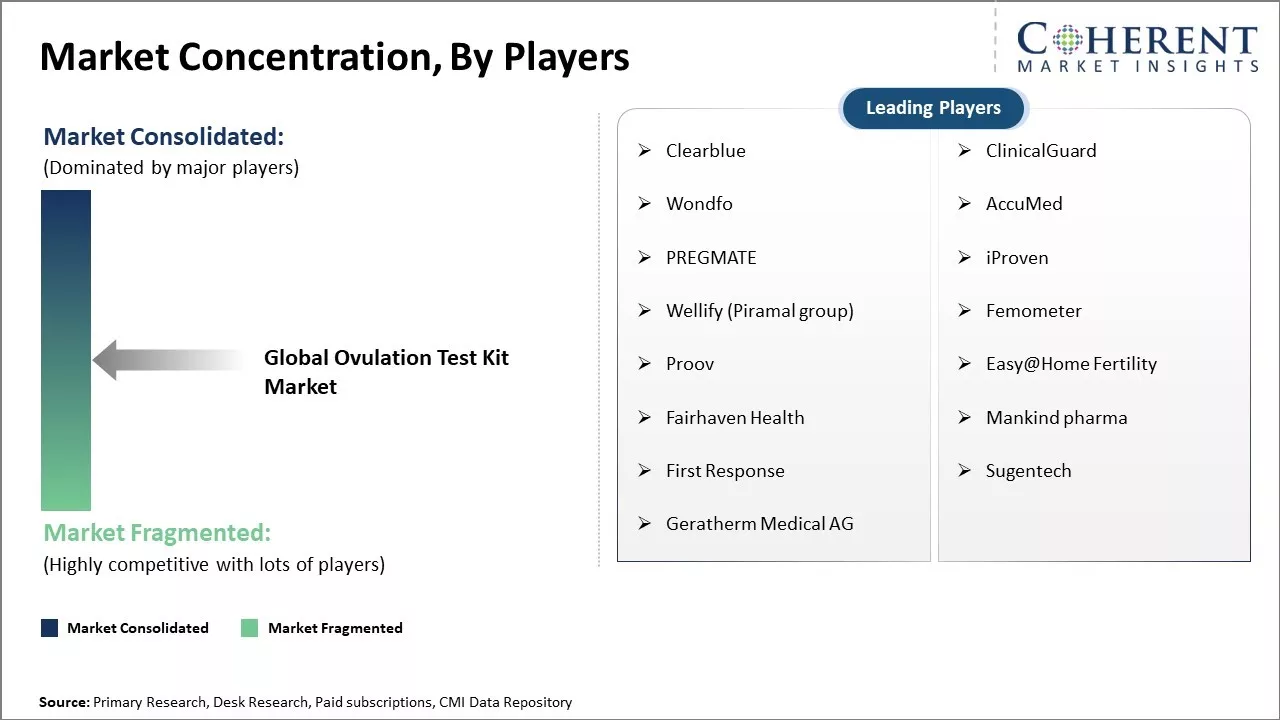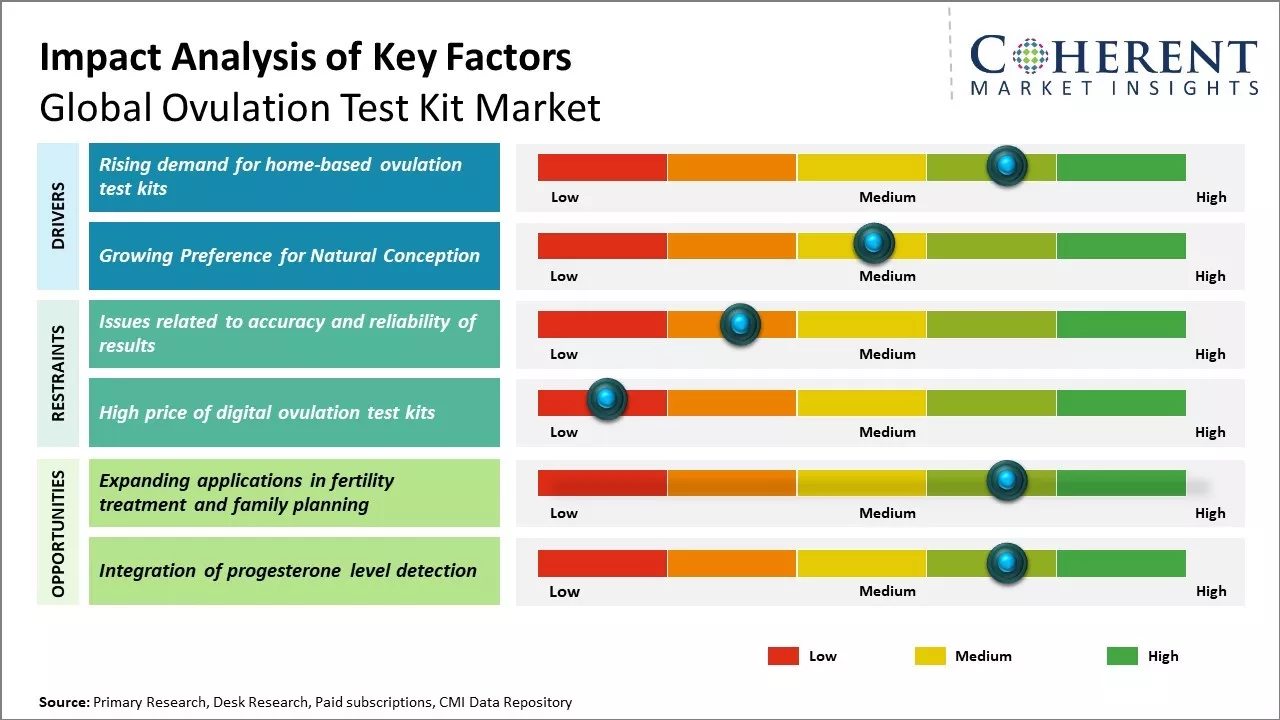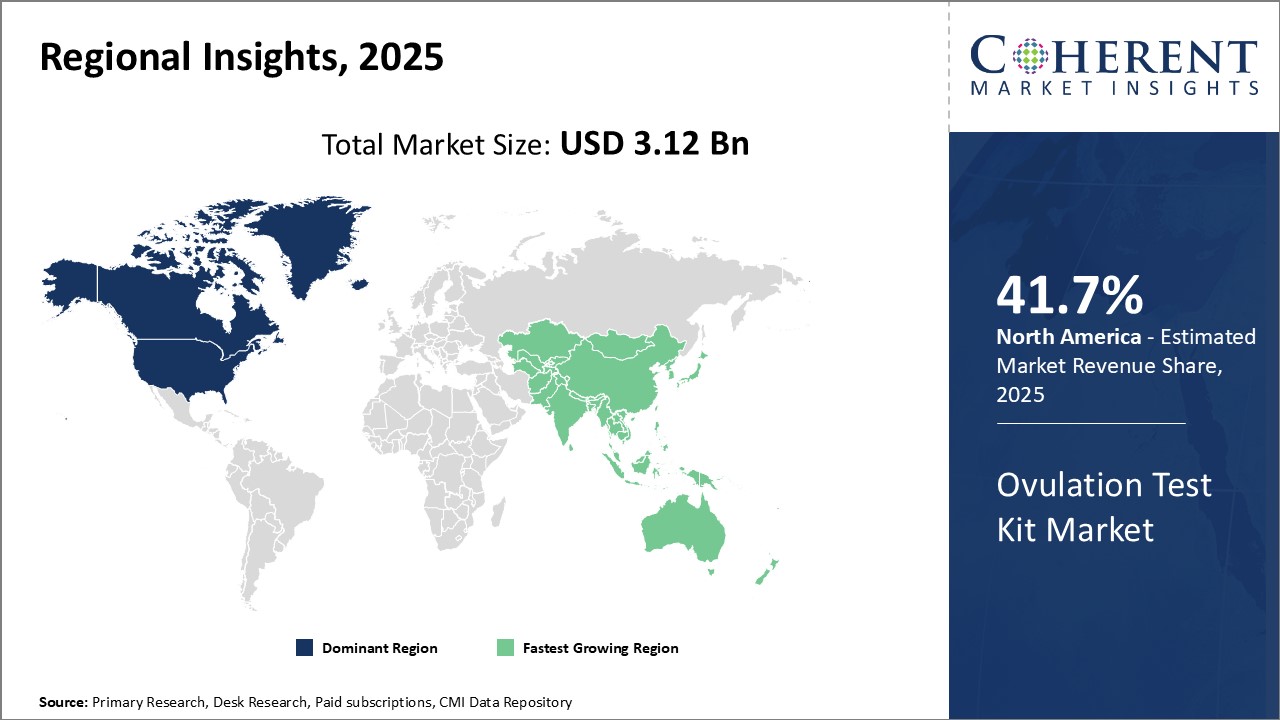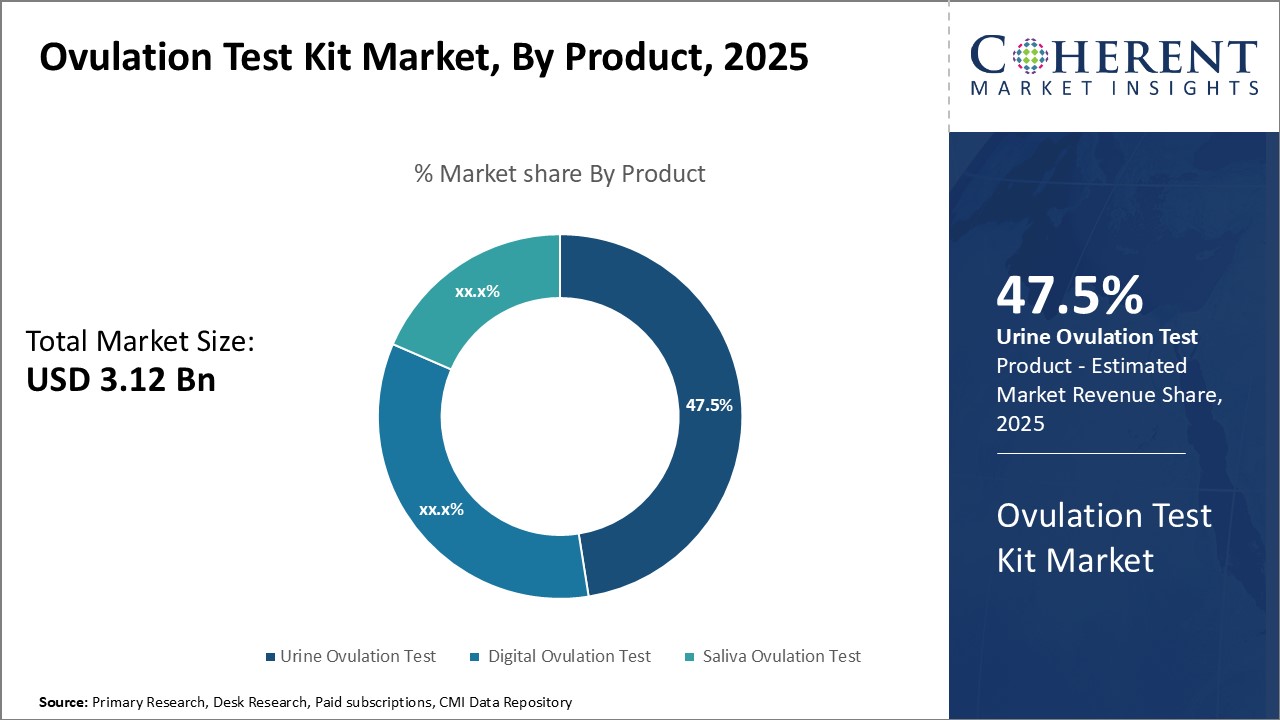Global Ovulation Test Kit Market Size and Trends
The global ovulation test kit market is estimated to be valued at USD 3.12 Bn in 2025 and is expected to reach USD 4.91 Bn by 2032, exhibiting a compound annual growth rate (CAGR) of 6.7% from 2025 to 2032.
Key Takeaways:
- Based on product, the urine ovulation test segment is estimated to acquire a prominent share of 47. 5% in 2025, owing to its non-invasive nature and simplicity.
- Based on the sales channel segment, the offline segment is expected to contribute the highest market share of 55.5% in 2025, due to instant access within local communities.
- In terms of the end user segment, the individual/personal use segment is expected to contribute the highest market share of 40.5% in 2025, as women highly prioritize fertility health.
- North America, holding an estimated market share of 41.7% in 2025, is projected to lead the overall ovulation test kit market, owing to the easy availability of various ovulation test kit brands.
Market Overview
Fertility treatment and family planning have gained extensive popularity globally, thus bolstering the utilization of ovulation test kits. In addition to this, consumers are increasingly opting for ovulation test kits to plan pregnancies and monitor fertility cycles effectively. Rising women empowerment and financial independence have prompted women to make well-informed healthcare decisions, boosting the sales of ovulation test kits.
Various technological innovations in ovulation test kits, such as smartphone apps, have made tracking fertility cycles more flexible as well as user-friendly. Leading manufacturers are engaged in new product launches with improved accuracy, along with portability to cater to changing consumer needs. However, factors such as social stigma surrounding fertility screening in some countries and the easy availability of alternative fertility monitoring options can hamper the growth of the market.
Role of AI (Artificial Intelligence) in the Ovulation Test Kit Market
The fertility monitoring landscape is rapidly evolving through the integration of artificial intelligence, enhancing precision, personalization, and convenience for users.
- Mira Multi-Hormone Prediction, leverages AI to analyze LH, estrogen, PdG, FSH levels, basal body temperature, cervical mucus, and historical cycle data. Mira reports that 84 % of users conceive within six cycles, including those with Polycystic Ovary Syndrome (PCOS).
- Harvard researchers developed a smartphone-integrated, AI-enabled saliva ‘ferning’ test that achieves >99% ovulation prediction accuracy—drawing on neural network image classification of microfluidic chip samples.
Market Concentration and Competitive Landscape

To learn more about this report, Download Free Sample
- Leading global players including Clearblue, Wondfo, Easy@Home, Proov, and Geratherm Medical AG maintain strong market positions through comprehensive product ranges, dual-hormone detection, digital integration, and trusted brand equity.
- Niche innovators such as AdvaCare Pharma, Mosie, Hangzhou Singclean, Nectar Lifesciences, and BioMerieux differentiate through analog strip reliability, smartphone analytics, multi-hormone sensors, and wearable fertility devices.
Current Events and their Impact on the Ovulation Test Kit Market
|
Current Events |
Description and its impact |
|
Technological Innovations
|
|
|
Regulatory Shifts in Key Markets |
|
Uncover macros and micros vetted on 75+ parameters: Get instant access to report

To learn more about this report, Download Free Sample
Ovulation Test Kit Market Trend
Rising Demand for Home-based Ovulation Test Kits
Growing demand for home-based ovulation test kits drives the market growth. In addition to this, women now are preferring the convenience of using home kits rather than visiting clinics or labs for ovulation testing, with changing lifestyles and work patterns. Home kits also allow women to test for their fertile window privately and as per their schedule without taking time out from their busy routines.
Delayed childbearing is now a growing trend in many developed nations. As women try to conceive at an older age, they are more reliant on ovulation tests to accurately identify their fertile window and maximize their chances of conception each month.
Advanced digital home test kits that are easy to use and provide clear results have furthered this shift. These allow women to closely monitor their fertility without difficulties. Moreover, rising awareness about natural birth control methods like fertility awareness-based methods (FABMs) has boosted the uptake of ovulation test kits.
Growing Preference for Natural Conception
Rising preference for natural, medical‑free conception is fueling market growth, as more couples rely on ovulation test kits to accurately time intercourse prioritizing privacy, autonomy, and cost-effective alternatives to clinical fertility treatments. There is also a perception that it may reduce risks, costs, and side effects as compared to treatments like IVF. Furthermore, lifestyle changes amid the pandemic provided many couples ample time to focus on their family planning goals in a relaxed setting. This environment has made home-based solutions like ovulation test kits more attractive.
As a result, the sales of ovulation test kits have increased over the last few years. This unmet need, as well as the convenience and privacy offered by ovulation test kits, can boost their adoption. At the same time, progressive normalization of conversations around fertility and family planning has removed much of the stigma around these products.
According to a report published by United Nations Population Fund, in June 2025, State of World Population (SOWP) Report, titled, ‘The Real Fertility Crisis,’ states that one in three adult Indians (36%) face unintended pregnancies, while 30% experience unfulfilled desire for having either more or fewer children. Notably, 23% faced both.
Ovulation Test Kit Market Opportunities: Expanding Applications in Fertility Treatment and Family Planning
Expanding applications in fertility treatment and family planning are offering numerous opportunities for the growth of ovulation test kit market. Ovulation test kits are no longer just used to achieve pregnancy but also to prevent unintended pregnancies. Their usage allows women to understand their fertility cycle in a non-invasive manner and make informed choices.
According to the United Nations Population Fund's 2025 report, data from the past five years reveal that approximately one in ten women are unable to decide whether to use contraception. Around one-quarter of women cannot make decisions regarding their own healthcare, and a similar proportion are unable to refuse sex. Millions and millions of people still, therefore, cannot exercise their reproductive rights and choices. This inability of individuals to realize their desired fertility goals is the real fertility crisis.
As awareness of family planning increases globally, more individuals are expected to incorporate ovulation tracking into their routine for achieving or avoiding pregnancy with accuracy. At the same time, rising infertility rates has led to huge demand for assisted reproductive technology and fertility treatments.
Ovulation Test Kit Market Insights, by Product - Urine ovulation tests contribute the highest share of the market, owing to their ease of use
In terms of product, the urine ovulation test segment is expected to contribute the highest market share of 47.5% in 2025, due to its non-invasive nature and simplicity. Urine tests are considered the most effective as well convenient option for ovulation prediction, as all that is required is for a woman to test her urine using indicator strips. Moreover, the simplicity and hassle-free process encourage compliance and frequent testing. This makes them acceptable to more women, including those uncomfortable with invasive approaches.
The convenience factor drives the segment growth, as busy modern lifestyles leave little time or energy for complex medical procedures even for health monitoring. Urine tests fit neatly into most women's daily schedules without disruption.
A study conducted by Indian Journal of Obstetrics and Gynecology Research, Luteinizing hormone (LH) surge kits diagnosed ovulation induction in 78 (54.17%) of the 144 women, and TVS was used in 66 (45.83%) of the women. The LH surge group suffered infertility for 4.32 years, whereas the TVS group had it for 4.7 years (p=0.7743). Primary infertility occurred in 71.79% of group 1 and 72.72% of group 2. These factors are further positively influencing the ovulation test kit market share.
Ovulation Test Kit Market Insights, by Sales Channel - Offline accessibility fuels market for in-person sales
In terms of sales channel, the offline segment is expected to contribute the highest market share of 55.5% in 2025, due to ready access within local communities. Wide distribution through drug stores, supermarkets, and small retail outlets, and placement in high footfall areas ensures ovulation test kits remain visible and discoverable, and improve impulse buys.
Offline retailers also permit touch-and-feel product selection and immediate purchase. According to the U.S. Bureau of Labor Statistics, as of February 2025, the category comprising prescription drugs, over-the-counter medications, and other medical equipment and supplies accounted for 1.527% of the Consumer Price Index (CPI), representing 18% of the broader Medical Care Index. This supports choosing based on real-time needs or upcoming cycles.
Local familiarity and relationships build shopper trust in product recommendations over anonymous online opinions. Placements in outlets common to daily or weekly routines optimize access through habits already formed which is responsible for the growth of the market.
Ovulation Test Kit Market Insights, by End User
In terms of end user, the individual/personal use segment is expected to contribute the highest market share of 40.5% in 2025, as women increasingly prioritize fertility health. The rising focus on wellness and the natural conception of women brings ovulation monitoring into the self-care routines of many women. In line with this, heightened health consciousness as well as wanting active roles drive personalizing family planning decisions, including tracking own cycles. For instance, the United Nations partnered call for investments in self-care interventions to improve sexual and reproductive health, which aim to help people gain autonomy over their health while improving access to vital healthcare. In line with this, individuals are exploring supportive apps and connected ovulation tools encouraged by social media platforms.
Reimbursement Policies in the Ovulation Test Kit Market
The market for ovulation test kits is greatly influenced by reimbursement rules, which raise affordability and adoption. In the U.S., many health plans reimburse urine-based ovulation kits and fertility trackers as qualifying medical costs, making them eligible for coverage under HSAs, FSAs, and HRAs. Despite eligibility, practical reimbursement often requires navigating complexities, such as obtaining physician prescriptions, using correct CPT/HCPCS codes (e.g., A9293 or Z30.8), and appealing insurer denials. In emerging markets like India, fertility testing coverage remains limited, typically excluded from standard health insurance plans unless included via optional top‑ups or government schemes.
Emerging Innovations in Ovulation Test Kit Market
1. Saliva-Based Saliva Ovulation Predictor Kit
Application
: The saliva-based ovulation predictor kit analyzes dried saliva under a microscope to detect estrogen-induced "ferning" patterns—an indicator of approaching ovulation. As estrogen rises before ovulation, increased salinity causes crystalline fern-like formations in saliva. It's reusable, eco-friendly, and does not require disposable test strips—making it convenient and cost-effective for long-term fertility tracking.Example
: KNOWHEN’s Advanced Saliva Ovulation Test uses a drop of saliva analyzed under a mini-microscope to detect estrogen-induced “ferning” patterns—98.9% accurate and FDA-cleared —and syncs with a smartphone app to track fertile windows naturally, sustainably, and incurring zero strip waste.2. Easy@Home ovulation test strips with Premom app
Application
: The Easy@Home ovulation test strips, when used in conjunction with the Premom app, digitize and streamline fertility tracking. This integration enhances accuracy—especially for users with irregular cycles or PCOS—and offers real-time fertile window predictions. It also aggregates basal body temperature and menstrual data to generate personalized insights, helping individuals time intercourse more effectively and facilitating data-driven discussions with healthcare providers.Example
: Easy@Home expanded its product line with ovulation test strips that integrate with the Premom app. Users can scan their test results using the app, which then analyzes the data to provide personalized fertility insights. This integration enhances accuracy and user engagement by offering real-time tracking and trend analysis. The app's capabilities include logging basal body temperature and other fertility indicators, providing a comprehensive view of the user's reproductive health.3. Frida launched a comprehensive fertility kit to simplify the conception process
Application
: The Frida Fertility Ovulation & Pregnancy Test + Track Set combines dual-function LH surge detection and early pregnancy testing in a single kit designed for home use. The kit includes a tracker card to record results, highlighting the 24–48‑hour fertile window with >99% accuracy. This streamlined, hygienic system simplifies fertility monitoring by minimizing mess, reducing disposable waste, and consolidating sampling and tracking into one ergonomic, user-friendly setExample
: In May 2023, Frida, a brand known for its innovative baby and maternity products, launched a comprehensive fertility kit designed to simplify the conception process. This kit includes an ovulation test with a collapsible urine cup featuring a built-in ledge to hold test strips, addressing common issues associated with sample collection. The design aims to streamline the testing process, making it more user-friendly and less messy.4. Vivoo introduced a suite of reproductive hormone tests at CES 2025
Application: Vivoo’s new hormone test suite enables at-home urine monitoring of key reproductive biomarkers—follicle-stimulating hormone (FSH), luteinizing hormone (LH), human chorionic gonadotropin (hCG), and vaginal pH. The app visualizes fertility levels and cycle timing in an interactive calendar, empowering individuals to optimize conception planning and monitor reproductive health without clinical visits
Example: In January 2025, Vivoo introduced a suite of reproductive hormone tests at CES 2025, including tests for FSH, LH, and hCG levels. These tests utilize deep learning image processing technology to provide results within seconds after urination, offering enhanced cycle-tracking accuracy compared to software-only solutions. The results are displayed in the Vivoo app, providing users with personalized insights into their reproductive health
Regional Insights

To learn more about this report, Download Free Sample
North America Ovulation Test Kit Market Trends
North America dominates the global ovulation test kit market, with an estimated market share of 41.7% in 2025. The presence of leading manufacturers and distributors in the region is making easy availability of various ovulation test kit brands that have made them a household product.
Furthermore, rising awareness about fertility-related issues among women and acceptance of family planning options like ovulation tests have also boosted their adoption. Strong healthcare infrastructure and favorable reimbursement policies for family planning products by private as well as public payers drive sales. Rapid modernization, busy lifestyles, and delayed parenthood have increased the dependence on ovulation test kits for planning pregnancies.
Asia Pacific Ovulation Test Kit Market Trends
Asia Pacific region has emerged as the fastest-growing market for ovulation test kits globally due to its massive population base and improving access to healthcare facilities. Increasing literacy, changing social mindsets, and rising middle-class consumer purchasing power are encouraging women to opt for ovulation test kits.
According to the data published by the United Nations, In Central Asia, fertility declined rapidly following the collapse of the Soviet Union, but since the late 1990s and early 2000s, the trend has reversed or stalled. These trends can be linked to significant cultural, social and economic changes in these post-Soviet states.
Rapid urbanization and economic progress in countries like India, China, Indonesia, and others have led to convenient access to ovulation test kits through expanding modern retail outlets and online sales channels. Moreover, growing medical tourism for assisted reproductive technologies in Asia Pacific economies like India and Thailand has boosted the usage of ovulation test kits in the region.
U.S. Ovulation Test Kit Market
The U.S. ovulation test kit market is expanding significantly due to improvements in product technology and growing awareness of reproductive health. The region is dominating due to the predominance of urine-based ovulation tests, owing to their improved accuracy and compatibility with smartphone apps. Moreover, the broad availability of fertility products in North America, as evidenced by the expansion of fertility wellness sections by major pharmacy chains and the rise in sales reported by e-commerce platforms, further supports this trend.
China Ovulation Test Kit Market Trends
The ovulation test kit market in China is experiencing significant growth, driven by increasing awareness of reproductive health and advancements in fertility monitoring technologies. The demand is anticipated to be driven by a number of factors, including the availability of ovulation test kits and the growing investments in the development of fertility and ovulation monitors. In line with this, growing numbers of first-time pregnancies, falling fertility rates, rising disposable incomes, and continuous improvements in ovulation testing techniques are responsible for the growth of the market.
End User Feedback and Unmet Needs in the Ovulation Test Kit Market
- Accuracy Concern: Users frequently report issues with false positives and negatives, particularly among those with hormonal imbalances such as PCOS or thyroid disorders. These inaccuracies can lead to confusion and decreased trust in the product's reliability
- Ease of Use: Digital ovulation tests and app-integrated kits are praised for their user-friendly interfaces and real-time tracking capabilities, enhancing the testing experience and user engagement.
- Cost-effectiveness: High-quality ovulation test kits can be cost-prohibitive, especially for individuals without health insurance coverage. This financial barrier limits access to essential fertility tracking tools.
Pricing Analysis
- Urine-Based Test Kits: These are the most prevalent and affordable options. Basic test strips are priced between USD 0.03 to USD 0.22 per piece, making them accessible for daily use. Midstream and cassette types are slightly more expensive, ranging from USD 0.05 to USD 0.27 per piece.
- Premium and Specialized Kits: Products with features like multi-hormone detection, AI-powered result interpretation, or eco-friendly materials are positioned in the premium segment. These can be priced between USD 50 to USD 200, catering to consumers seeking advanced fertility tracking solutions.
Market Report Scope
Ovulation Test Kit Market Report Coverage
| Report Coverage | Details | ||
|---|---|---|---|
| Base Year: | 2024 | Market Size in 2025: | USD 3.12 Bn |
| Historical Data for: | 2020 To 2024 | Forecast Period: | 2025 To 2032 |
| Forecast Period 2025 to 2032 CAGR: | 6.7% | 2032 Value Projection: | USD 4.91 Bn |
| Geographies covered: |
|
||
| Segments covered: |
|
||
| Companies covered: |
Clearblue, Adisseo, ClinicalGuard, Wondfo, AccuMed, PREGMATE, iProven, Wellify (Piramal group), Femometer, Proov, Easy@Home Fertility, Fairhaven Health, Mankind pharma, First Response, Sugentech, and Geratherm Medical AG |
||
| Growth Drivers: |
|
||
| Restraints & Challenges: |
|
||
Uncover macros and micros vetted on 75+ parameters: Get instant access to report
Ovulation Test Kit Industry News
- On February 28, 2025, NewGenIvf Group Limited finalized its acquisition of MicroSort Reproductive Technology, a strategic move aimed at enhancing its capabilities and market presence in advanced fertility solutions, particularly in gender selection and sperm-sorting technologies.
- In July 2023, 2San, a global leader in self-diagnostic testing, entered into a partnership with Proov to distribute Proov’s proprietary, user-friendly ovulation test kits. This collaboration aims to broaden access to innovative and easily interpretable fertility tracking solutions, enhancing convenience and usability for consumers.
Analyst Opinion (Expert Opinion)
- The ovulation test kit market stands at a pivotal juncture. While growth trajectories remain robust, the sector faces pressing challenges that demand immediate attention from manufacturers and stakeholders.
- Multi-hormone detection kits, which assess both LH and estrogen levels, have shown to enhance fertility prediction accuracy by approximately 18% over single-hormone tests. Despite this, their adoption remains limited, partly due to higher costs and perceived complexity. Manufacturers must prioritize education and accessibility to unlock the full potential of these advanced tools.
- Digital ovulation test kits, which sync with mobile applications, offer real-time tracking and personalized insights. While they represent the future of fertility monitoring, their effectiveness is contingent on user engagement and data accuracy. The reliance on smartphone connectivity also introduces potential barriers for users in regions with limited digital infrastructure.
- Environmental concerns are increasingly influencing consumer choices. Biodegradable and recyclable test kits are gaining traction, with over 9.1 million units sold globally in 2024. Companies that fail to integrate sustainability into their product development risk alienating a growing segment of eco-conscious consumers.
Market Segmentation
- Product Insights (Revenue, USD Bn, 2020 - 2032)
- Urine Ovulation Test
- Test Strip Type
- Cassette Type
- Midstream Type
- Digital Ovulation Test
- Saliva Ovulation Test
- Urine Ovulation Test
- Sales Channel Insights (Revenue, USD Bn, 2020 - 2032)
- Online
- Offline
- End User Insights (Revenue, USD Bn, 2020 - 2032)
- Individual/Personal use
- Hospitals/Clinics
- Fertility Centers/ Clinics
- Research Institutes/Medical Colleges
- Others
- Regional Insights (Revenue, USD Bn, 2020 - 2032)
- North America
- U.S.
- Canada
- Latin America
- Brazil
- Argentina
- Mexico
- Rest of Latin America
- Europe
- Germany
- U.K.
- Spain
- France
- Italy
- Russia
- Rest of Europe
- Asia Pacific
- China
- India
- Japan
- Australia
- South Korea
- ASEAN
- Rest of Asia Pacific
- Middle East
- GCC Countries
- Israel
- Rest of Middle East
- Africa
- South Africa
- North Africa
- Central Africa
- North America
- Key Players Insights
- Clearblue
- ClinicalGuard
- Wondfo
- AccuMed
- PREGMATE
- iProven
- Wellify (Piramal group)
- Femometer
- Proov
- Easy@Home Fertility
- Fairhaven Health
- Mankind pharma
- First Response
- Sugentech
- Geratherm Medical AG
Sources
Primary Research Interviews:
- Ovulation Test Kit Manufacturers
- Healthcare Professionals
- Distributors & Retailers
- Fertility Clinics
- Others
Magazines:
- Fertility & Sterility Magazine
- Women’s Health Magazine
- Others
Journals:
- Journal of Assisted Reproduction and Genetics
- Reproductive Biomedicine Online
- Journal of Women’s Health
- Others
Newspapers:
- The New York Times
- The Guardian
- The Washington Post
Associations:
- American Society for Reproductive Medicine (ASRM)
- International Federation of Fertility Societies (IFFS)
- National Infertility Association (RESOLVE) for patient advocacy and support resources
- The American College of Obstetricians and Gynecologists (ACOG)
- Others
Public Domain Sources:
- Centers for Disease Control and Prevention (CDC)
- World Health Organization (WHO)
- National Institutes of Health (NIH)
Proprietary Elements:
- CMI Data Analytics Tool
- Proprietary CMI Existing Repository of information for the last 8 years
*Definition: The ovulation test kit market encompasses the global industry involved in the development, manufacturing, distribution, and sale of devices designed to detect ovulation in individuals aiming to conceive or monitor their reproductive health. These kits primarily function by identifying hormonal surges—such as luteinizing hormone (LH) or estrogen—in urine or saliva, indicating the most fertile period within a menstrual cycle. Product offerings include urine-based test strips, digital devices, and saliva-based monitors.
Share
Share
About Author
Komal Dighe is a Management Consultant with over 8 years of experience in market research and consulting. She excels in managing and delivering high-quality insights and solutions in Health-tech Consulting reports. Her expertise encompasses conducting both primary and secondary research, effectively addressing client requirements, and excelling in market estimation and forecast. Her comprehensive approach ensures that clients receive thorough and accurate analyses, enabling them to make informed decisions and capitalize on market opportunities.
Missing comfort of reading report in your local language? Find your preferred language :
Transform your Strategy with Exclusive Trending Reports :
Frequently Asked Questions
EXISTING CLIENTELE
Joining thousands of companies around the world committed to making the Excellent Business Solutions.
View All Our Clients

